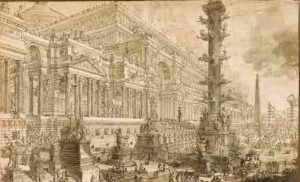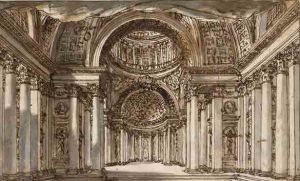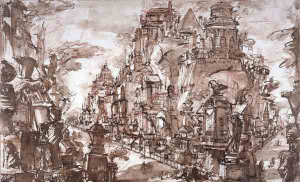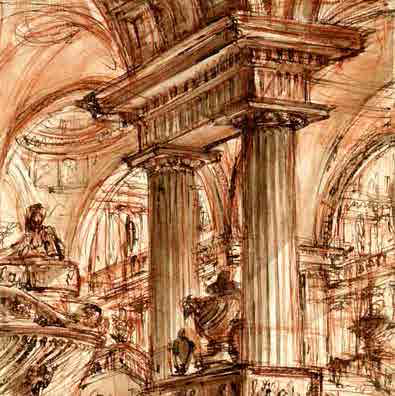A visit to Long Biên
By Tuan Nguyen
12th March 2020 12:45 GMT
A Visit to Long Biên
Small spaces | Không gian xen kẹt
Cemetery Design
Renovation Architectural Studio
Urban Sketching
Guitar
Filmaking
Wood Structure
Digital Modeling
Watercolor
Placemaking
Bamboo Workshops
Earth Construction
Wood Carving
Creative Writing
Urban Sketching
Guitar
Filmaking
Wood Structure
Digital Modeling
Watercolor
Placemaking


If you’re familiar with the work of Giovanni Battista Piranesi (1720-1778), it is likely due to the famous macabre etchings of imaginary prisons, Carceri, mirroring the violence of his 18th-century Italy, and tragically germane to our era’s atrocities. A forerunner of surrealism, his imaginary architectural fantasies were resplendent with multiple vanishing points, staircases ending in mid-air, arches spanning uncertain ground, and dazzling light from unseen windows outlining a prison alarmingly without cells. While deserving fame, Piranesi’s Carceri comprises 16 out of approximately one thousand architectural etchings he created. And in addition to that wealth of etchings, there are over a thousand drawings.
His drawings are just as singular in the history of architectural art as the etchings, albeit lesser known. And this year, the 300th anniversary of Piranesi’s birth, is marked by two shows of the drawings: “Sublime Ideas: Drawings by Giovanni Battista Piranesi,” opening in May at The Morgan Library in New York City, and The British Museum. Thames & Hudson has just published an outstanding exhibition catalogue for the British Museum show, Piranesi Drawings: Visions of Antiquity. Authored by curator Sarah Vowles, the text is concise, lucid, and well complemented by excellent reproductions of 50 drawings. When the drawings relate to Piranesi’s etchings, the etchings are reproduced en face. This book works as an inspiring guide for anyone not only interested in Piranesi’s eccentric genius, but also pondering unconventional interpretations of architectural classicism.
What follows is less a book review – you already have my book recommendation – than a meditation of why Piranesi’s art matters more than ever in reinterpreting classicism.
- A monumental staircase in a vaulted interior with columns, c. 1750-55
- Painting
Timeline

The AF is pleased to announce the return of the Modern Camden Housing series, exploring the products of the experimental 1960s and 70s under the leadership and drive of London Borough of Camden architect Sydney Cook. In the second part of the series, the tour will focus on the southern area of the London Borough of Camden.
Modern Camden Housing South
North west London has been a laboratory for radical housing experiments since the early 19th century. Emerging from this exciting landscape came Local Authority architects critical of the post war modernist point and slab block (‘mixed’) developments and energised by the challenge of building low-rise, high-density estates. Not without criticism, the social housing they built during this period has become some of the most iconic 20th century housing in the world.
This walking tour will explore the inner city, southern area of Camden with much more ambitious post-war housing density requirements. We will visit the Foundling Estate (now known as the Brunswick Centre) by the unofficial father of the movement, Patrick Hodgkinson and the Oakshott Court Estate (now known as Polygon Road) by the unsung hero of the group, Peter Tabori. We will also explore the flagship Maiden Lane estate designed by Neave Brown’s celebrated protégées Benson & Forsyth.

Other highlights of the walk include an early housing scheme by Farrell and Grimshaw Partnership on Millman Street, the historic Somers Town and Goldington Road estates and ongoing regeneration schemes by DSDHA, Mae, HawkinsBrown, Morris+Company, dRMM and Adam Khan Architects which are all part of a DSDHA-designed masterplan for the area.
Leading the tour will be Aidan Hall and Rosalind Peebles, both practicing architectural designers armed with the skills to bring this debate into the present day. Within a climate of an accommodation crisis in London, rising homelessness and with the number of flats recently surpassing the number of houses (a gap set to increasingly widen), these precedents have never been more pertinent.
In line with current social distancing advice, this small size-group tour will be conducted using audio sharing with all participants invited to listen while maintaining two metres distance from people outside their household. Please bring a smart phone and headphones. Participants are encouraged to attend only if the event is local to them or they can easily walk or cycle to the start without using public transport. Masks are optional but kindly encouraged for everyone’s safety.
Tour Guides:
Aidan Hall is a co-founder and director of OKRA studio CIC where he leads community, arts and low-cost housing projects, with a keen interest in adaptability and generosity at a low cost. He is a visiting lecturer and tutor of architecture at the Royal College of Art, Central Saint Martins and the Sir John Cass School of Architecture and Design and has written for Blueprint’s Design Curial. He has led walking tours for the Architecture Foundation since summer 2017.
Rosalind Peebles is interested in the social responsibility of Architecture, specifically focusing on housing in London. Her research has focused on exploring alternative housing typologies and investigating the balance between economy and generosity when approaching housing design. She has previous experience working for a number of practices in London and currently works for alma-nac. She has led tours for the Architecture Foundation since 2018.
Appeared in Kecho Journal, 321 March 2020
More Interview Topics Chisenhale Gallery Whitworth Art Gallery
Baltic Centre Imran Perretta
The writer’s essay The name implies that it is an essay written by an author writes about essay writer the subject of their choice. A background and summary should be supplied by the author. Once that is done, the writer will begin to write your essay according to style. Utilize 12 points. font, and double space the text. When you use quotation marks, the title should be included. The title of the piece should be in quotation marks. The assignment page should not be in the paper.






